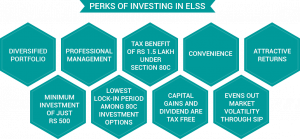Contents
- Best Tax Saver Mutual funds for you to invest in,
- Get high returns on your investment along with great tax benefits,
- With ELSS, you can save around Rs. 47,000 in taxes,
- Lock-in period of just 3 years – least amongst all other 80C Exemption options,
- Start investing with as low as Rs. 500 monthly in SIP.
For every individual with an earning, tax-saving investment is a significant part of their financial planning. Section 80C of the Income Tax Act offers Investors have the option to claim deductions from their taxable income through investments in certain Mutual Fund Schemes, under Section 80C of the Income Tax Act. Investing in the Best ELSS Funds offers one such option for tax saving, which is one benefit more than the rest of the mutual funds benefits.
Best ELSS Mutual Funds
At the time of purchasing even a tiny item for everyday use, such as a pen, we take a trial of whether it writes smoothly or not. Similarly, when investing our hard-earned money, for a few years, you must analyze different parameters and then invest in the most suitable one. This decision would depend upon your financial goals, investment horizon, and risk appetite.
The following table represents the Top Performing ELSS funds based on their growth and returns during the past 3 years. You may have different benchmarks to consider, such as returns of 5 years, or something else.
| Best ELSS Funds | 3-Year Returns | 5-Year Returns | |
|---|---|---|---|
| 15.81% | 14.01% | ||
| 15.38% | 15.79% | ||
| 14.4% | 17.62% | ||
| 14.58% | 16.88% | ||
| 13.58% | 18.06% | ||
| 14.08% | 17.76% | ||
| 13.6% | 16.6% | ||
| 14.13% | 14.26% |
PS: The Returns stated above were as on March 29, 2019. These are subject to change according to the market conditions. Do check the current details by clicking on the corresponding link.
More about ELSS Mutual Funds
ELSS are equity mutual funds schemes. They are quite similar to diversified equity funds of Mutual Funds. Which means that the significant part of the capital goes into buying equity stocks of companies listed on the stock exchanges.
These are the only mutual fund plans that help you avail tax savings. Mostly, they come in with a lock-in period of a minimum of 3 years. You can invest either in Lump Sum investment or SIP. The SIP Plans could be started with as low as Rs. 500 with no upper limit.
Who should opt for ELSS?
If you are willing to take risks with an expectation of high returns, you may choose ELSS funds. Since these investments are equity-oriented, therefore there is a risk of volatility. Moreover, owing to the same reason, it is advisable to keep invested for a longer duration than only completing the lock-in period of 3 years.
Additionally, if you have just started your career and can invest as small payments or invest in SIP and for a long period of time, you can opt for those ELSS funds that have a high-risk factor. Because these would give higher returns compared to others.
Benefits of investing in ELSS

Best ELSS Funds: Benefits of ELSS: WealthBucket
- Tax benefits at the Time of Investing: You get tax benefits under section 80C of the Income-tax Act.
- Shortest Duration: The lock-in period of 3 years is comparatively lesser than other close-ended mutual funds. Or even most other tax-saving investment. This lock-in is the only difference between the Diversified Equity Mutual Funds & the ELSS. PPF has a maturity period of 15 years.
- Lower Tax on the Returns: As per the current tax law, the gains above Rs. 1,00,000 are taxable at the rate of 10%. Whereas, the short-term capital gains are taxed at a rate of 15%. Hence, ELSS funds reduce the tax on mutual funds.
- Higher Returns: Since ELSS funds invest in equity schemes, the returns are higher (15-20%). When compared to other tax saving options such as PPF or NPS (generally, 7-10%). During the 3-year period, the benefit of compounding coupled with high returns from equity provides higher returns for investors.
- High Growth: Equity funds may be volatile in the short run, but, generally, are able to beat inflation and create wealth over the long run. So, if you are looking to invest in mutual funds, your capital that you don’t expect to withdraw in the near future. And are ready to ride the ups and downs of the equity market, you may find ELSS as an ideal tax saving option.
- Upper or Lower Limit: With the best SIP you can start really small, with only Rs. 500 per month. Whereas, there is no upper limit to invest.
- Experience of Market: You do not need to be a veteran and have extensive knowledge of the markets to invest in these funds. The funds are run by expert and experienced fund managers well-qualified to handle your investments.
Disadvantages of ELSS Mutual Funds
- Limit on Benefits: Tax benefits for the current financial year are available only up to an investment of Rs.50,000 under Section 80C, whatever the total amount of investment in an ELSS fund is. Even while calculating this, other benefits such as PPF, Life Insurance, Home Loan EMIs, etc. are taken into consideration.
- Limit of Time: By and large, ELSS deliver good returns only if invested for more than 5-years. In case, you are looking to invest for a shorter period, this is not the mode for you. In other words, it is advisable that you must enter into ELSS only if you are ready to keep invested for more than 5-years.
- Safety of Investment: Tax Saving Schemes such as PPF may be lower in gains, but the returns are guaranteed. So you are assured that you will receive this much amount at various intervals. Whereas, the risk profile of even the best ELSS funds is similar to any equity-oriented mutual fund scheme. The only difference between ELSS and Equity being tax deduction benefits.
Best ELSS Mutual Funds Options
- Growth: One option for investing in ELSS is the growth option. Here you will not receive any benefit paid in the form of dividends. You will only receive the gains at the end of the duration. This results in an increase in the total NAV, thereby multiplying the gains. The only drawback is that these returns would be subject to market fluctuations, which may or may not bring benefits as expected. Though, due to the same reasoning, the profits could be higher.
- Dividend: Under this option, you receive frequent and regular payments in the form of dividends. These dividends are completely tax-free.
- Dividend Reinvestments: This is an option in which you have an alternative of choosing to return the dividends received, whereby it is added to the NAV. This is a good choice, in case the market has been performing well and is expected to continue performing well.
How to choose the Best ELSS Mutual Funds

Best ELSS Funds: Points to consider before investing: WealthBucket
- Returns: You should look at how the Fund has been performing, since, at least, last 5-years, before investing in that particular Fund. Choose the Fund that has performed better than the benchmark of NIFTY or BSE Sensex and amongst other similar funds in the same time period.
- History of the Fund House: At the same time, you must look for the fund house that has performed consistently over a long period of time, say, at least 5-10 years.
- Expense ratio: This shows what portion of your invested amount is being used to manage the expenses of the Fund. You are advised to choose a fund with a lower expense ratio that would imply superior returns.
- Financial Conditions: There Are 5 main parameters of investment risks that apply to the analysis of stocks, bonds, and mutual fund portfolios. Such as Alpha, Beta, Standard Deviation, Sharpe ratio, and the Sortino ratio. These statistical measures are historical predictors of investment risk/volatility and used to analyze the performance of a fund. A fund with a higher Standard Deviation and Beta is riskier than a fund having lower Standard Deviation and Beta. You must choose funds that have a higher Sharpe Ratio as they give higher returns for any additional risk undertaken.
Choosing the Right Mutual Fund to invest, proves to be quite a burdensome task for any investor, be it a novice or a veteran. Therefore, if you are finding it time-taking and confusing to decide which fund suits your requirements best, worry not.
Help is just a call away, dial +91 9999379929. Or get registered at WealthBucket. You would be able to select amongst the best performing mutual funds, with the assistance of our experts, that is most suited to your needs.
We have a wide variety of services of Debt Mutual fund, Large Cap Mutual fund or Multi-Cap Mutual fund, to help you achieve your financial objectives.
Read Also:
State bank of India mutual funds (SBIMF): complete guide





